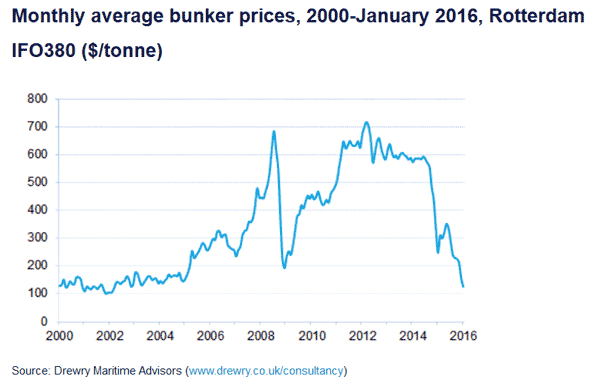Just like gasoline and diesel prices, the cost of the bunker fuel used by container ships has fallen dramatically over the past year and a half, potentially changing some dynamics in the way container ships manage their operations.
In 2008, bunker fuel costs spiked to about $700 per metric ton, up sharply from the $150 or so range seen in 2000-2004.
Supply Chain Digest Says... |
 |
| Drewry says it is possible a carrier and/or alliance may see this as an opportunity to gain a marketing advantage by offering a fast transit service on a few key routes. |
 |
What do you say? |
| Click here to send us your comments |
 |
| Click here to see reader feedback |
|
|
That jump had a big impact on the carrier's operating costs, and served as a catalyst for the practice of so-called "slow steaming," in which ships travel at a speed of about 18 knots, much slower than previous normal speed of 27 knots. There is also "super slow steaming," with travel at even lower speeds.
Marine engine manufacturer Wartsila calculates that reduction in speed reduces fuel consumption by a substantial 59%, at the cost of an additional week's sailing time on Asia to Europe routes, and an extra 4-7 days on trans-Pacific voyages to the North American West Coast.
But as seen in the chart below, bunker fuel costs have now collapsed, to not much more than $100 per ton, significantly reducing the cost advantage of slow steaming. In fact, according to the analysts at Drewry Shipping, from a pure cost perspective, with fuel costs this low the carriers would be better off to return to normal speeds and as a result be able to reduce the number of ships they have in service at a given time.
However, that is unlikely to happen for several reasons, Drewry says.
First, the container lines and the various alliances that have been created over the past few years have carefully planned their networks, including terminal berth windows, based on their present slow steaming speeds.

"To increase service speed would require major re-planning, and potential disruption," Drewry notes.
Second, there is no guarantee of course that bunker fuel prices won't swing back up, requiring the networks to be reformulated yet again.
Third, slow steaming benefits the carriers beyond lower operating costs, because it in effect serves to reduce industry capacity. With ship capacity in the industry continuing to grow faster than container volumes, pushing rates sharply downward, the last thing most carriers would want is a change that effectively adds more capacity to the supply-demand equation.
(See More Below)
|
CATEGORY SPONSOR: SOFTEON |
|
|
| |
|
|
Fourth, many ships, such as the giant new Maersk Triple E ships, have had physical and system changes to optimize sailing at the new normal of slow streaming, making a return to normal speeds more challenging or perhaps even impossible. The Maersk Triple E's, for example, have less powerful engines than previous large ships and have slightly different shaped hulls.
Drewry does expect some operational impact from the low fuel costs, however.
It says, for, example, that extra port calls may be added to loops, as the incremental cost of faster steaming will be lower.
Drewry also believes schedule reliability should improve because the container lines should be more willing to pay the now lower cost of speeding up to achieve an on time arrival if they are behind schedule.
And Drewry says it is possible a carrier and/or alliance may see this as an opportunity to gain a marketing advantage by offering a fast transit service on a few key routes. An expedited service, if you will, for the shipping industry.
Finally, Drewry says the fuel situation has also made operating smaller ships more viable from a cost perspective, especially the 4000-TEU type ships currently operating through the Panama Canal that many believed would not be financially viable when the Canal expands later this year to allow larger vessels through.
The low cost of bunker fuel "represents a stay of execution for the smaller Panamax ships," Drewry says.
Do you believe these low fuel costs will lead to a reduction in slow steaming? Let us know your thoughts at the Feedback section below.
Your Comments/Feedback
|